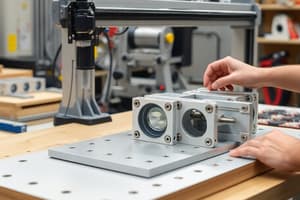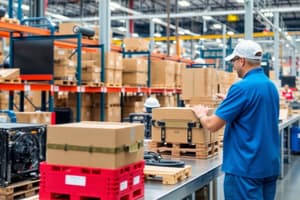Podcast
Questions and Answers
In the context of advanced manufacturing, how does concurrent engineering fundamentally alter the traditional sequential product development process to mitigate downstream complications?
In the context of advanced manufacturing, how does concurrent engineering fundamentally alter the traditional sequential product development process to mitigate downstream complications?
- By prioritizing marketing strategies over engineering design to capture a larger market share.
- By emphasizing departmental silos and segregating responsibilities to promote specialization.
- By relegating design considerations to the final stages of manufacturing to ensure adherence to budgetary constraints.
- By integrating all stages of product development, from design to manufacturing and marketing, into a parallel and collaborative effort. (correct)
What are the key considerations when integrating Design for Disassembly (DFD) principles into the product design phase, beyond simple ease of component separation?
What are the key considerations when integrating Design for Disassembly (DFD) principles into the product design phase, beyond simple ease of component separation?
- Optimizing material selection for remanufacturing, designing for non-destructive disassembly, and implementing modular design for component reuse. (correct)
- Minimizing material diversity to decrease the complexity of recycling processes alone.
- Focusing solely on reducing the number of fasteners to accelerate disassembly time without considering material recovery.
- Prioritizing aesthetic appeal to ensure market acceptance, even if it hinders efficient disassembly.
Which strategic approach is most effective for minimizing lifecycle environmental impact while maximizing resource utilization in green manufacturing?
Which strategic approach is most effective for minimizing lifecycle environmental impact while maximizing resource utilization in green manufacturing?
- Employing a cradle-to-grave assessment to optimize resource inputs and minimize waste generation at each stage. (correct)
- Focusing exclusively on energy efficiency during the production stage to reduce carbon footprint.
- Outsourcing manufacturing processes to regions with less stringent environmental regulations to reduce immediate costs.
- Implementing end-of-pipe pollution control technologies without altering production processes.
For a component subjected to high cyclic fatigue in a corrosive marine environment, what material selection strategy would provide the most reliable long-term performance?
For a component subjected to high cyclic fatigue in a corrosive marine environment, what material selection strategy would provide the most reliable long-term performance?
How does the choice of manufacturing process affect the overall sustainability and environmental footprint of a product, beyond direct energy consumption?
How does the choice of manufacturing process affect the overall sustainability and environmental footprint of a product, beyond direct energy consumption?
In the context of Computer-Integrated Manufacturing (CIM), what advanced data analytics technique enables proactive identification of potential equipment failures, minimizing downtime and maximizing operational efficiency?
In the context of Computer-Integrated Manufacturing (CIM), what advanced data analytics technique enables proactive identification of potential equipment failures, minimizing downtime and maximizing operational efficiency?
What key statistical process control (SPC) technique is most effective for monitoring and controlling process variation in real-time, allowing for immediate corrective actions to prevent defects?
What key statistical process control (SPC) technique is most effective for monitoring and controlling process variation in real-time, allowing for immediate corrective actions to prevent defects?
Within the framework of Lean Production, how does the application of Value Stream Mapping (VSM) transcend simple process visualization to drive continuous improvement and waste reduction?
Within the framework of Lean Production, how does the application of Value Stream Mapping (VSM) transcend simple process visualization to drive continuous improvement and waste reduction?
Assuming a small business is trying to compete in the market, what cost reduction strategy might be viable?
Assuming a small business is trying to compete in the market, what cost reduction strategy might be viable?
What is the most significant current trend reshaping the landscape of modern manufacturing, and how does it impact traditional production paradigms?
What is the most significant current trend reshaping the landscape of modern manufacturing, and how does it impact traditional production paradigms?
Flashcards
Manufacturing
Manufacturing
The process of converting raw materials into finished goods through machinery and labor.
Concurrent Engineering
Concurrent Engineering
A systematic approach integrating product design and manufacturing process planning.
Design for X
Design for X
Designing products considering ease of manufacturing, assembly, disassembly, and service.
Green Design
Green Design
Signup and view all the flashcards
Material Selection
Material Selection
Signup and view all the flashcards
Process Selection
Process Selection
Signup and view all the flashcards
Computer-integrated Manufacturing
Computer-integrated Manufacturing
Signup and view all the flashcards
Quality Assurance
Quality Assurance
Signup and view all the flashcards
Lean Production
Lean Production
Signup and view all the flashcards
Agile Manufacturing
Agile Manufacturing
Signup and view all the flashcards
Study Notes
- Manufacturing involves transforming materials into items of greater value through processes, design, and equipment.
Product Design and Concurrent Engineering
- Product design dictates the materials, processes, and equipment used in manufacturing.
- Concurrent engineering aims to reduce design time and production costs by considering all stages of a product's lifecycle simultaneously.
Design for Manufacture, Assembly, Disassembly, and Service
- Design for manufacturing focuses on ease of production.
- Design for assembly focuses on ease of putting parts together.
- Design for disassembly focuses on ease of taking parts apart.
- Design for service focuses on ease of maintaining and repairing a product.
Green Design and Manufacturing
- Green design focuses on eco-friendly and sustainable products and processes.
- Green manufacturing focuses on reducing waste and pollution.
Selection of Materials
- Material selection considers properties, cost, availability, and recyclability.
Selection of Manufacturing Processes
- Manufacturing process selection depends on production volume, part shape, material properties, and cost.
Computer-Integrated Manufacturing
- Computer-integrated manufacturing uses computers to control the entire production process.
Quality Assurance and Total Quality Management
- Quality assurance ensures products meet certain standards.
- Total quality management involves continuously improving all aspects of manufacturing.
Lean Production and Agile Manufacturing
- Lean production focuses on minimizing waste and maximizing efficiency.
- Agile manufacturing focuses on responding quickly to changing customer demands.
Manufacturing Costs and Global Competition
- Manufacturing costs include materials, labor, and overhead.
- Global competition pressures companies to lower costs and improve quality.
Trends in Manufacturing
- Trends in manufacturing include automation, additive manufacturing, and sustainable practices.
Studying That Suits You
Use AI to generate personalized quizzes and flashcards to suit your learning preferences.




